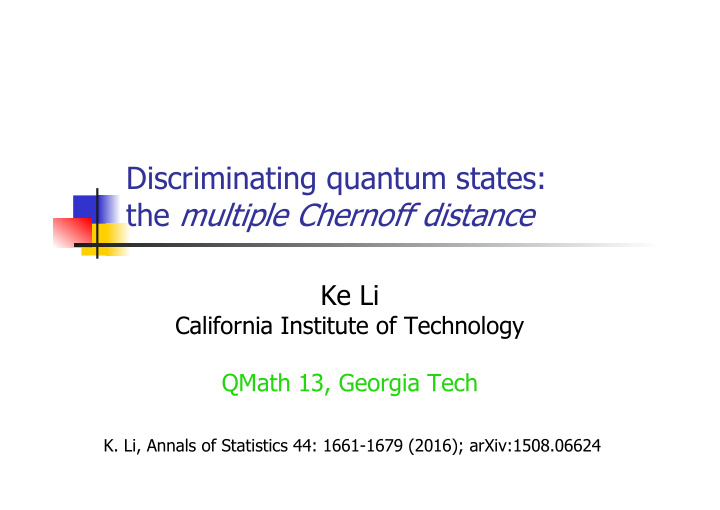



Discriminating quantum states: the multiple Chernoff distance Ke Li California Institute of Technology QMath 13, Georgia Tech K. Li, Annals of Statistics 44: 1661-1679 (2016); arXiv:1508.06624
Outline 1. The problem 2. The answer 3. History review 4. Proof sketch 5. One-shot case 6. Open questions
Accessing quantum systems: quantum measurement Quantum measurement: formulated as positive operator-valued measure (POVM) ; when performing the POVM on a system in the state , we obtain outcome " " with probability von Neumann measurement: special case of POVM, with the POVM elements being orthogonal projectors: where is the Kronecker delta.
Quantum state discrimination (quantum hypothesis testing) Suppose a quantum system is in one of a set of states , with a given prior . The task is to detect the true state with a minimal error probabality. Method: making quantum measurement . Error probability (let ) Optimal error probability
Asymptotics in quantum hypothesis testing What's the asymptotic behavior of , as ? Exponentially decay! (Parthasarathy '2001) But, what's the error exponent ? It has been an open problem (except for r=2)!
Outline 1. The problem 2. The answer 3. History review 4. Proof sketch 5. One-shot case 6. Open questions
Our result: error exponent = multiple Chernoff distance We prove that
Remarks Remark 1: Our result is a multiple-hypothesis generalization of the r=2 case. Denote the multiple quantum Chernoff distance (r.h.s. of eq. (1)) as , then with the binary quantum Chernoff distance is defined as Remark 2: when commute, the problem reduces to classical statistical hypothesis testing. Compared to the classical case, the difficulty of quantum statistics comes from noncommutativity & entanglement.
Outline 1. The problem 2. The answer 3. History review 4. Proof sketch 5. One-shot case 6. Open questions
Some history review The classical Chernoff distance as the opimal error exponent for testing two probability distributions was given in H. Chernoff, Ann. Math. Statist. 23, 493 (1952). The multipe generalizations were subsequently made in N. P. Salihov, Dokl. Akad. Nauk SSSR 209, 54 (1973); E. N. Torgersen, Ann. Statist. 9, 638 (1981); C. C. Leang and D. H. Johnson, IEEE Trans. Inf. Theory 43, 280 (1997); N. P. Salihov, Teor. Veroyatn. Primen. 43, 294 (1998).
Some history review Quantum hypothesis testing (state discrimination) was the main topic in the early days of quantum information theory in 1970s. Maximum likelihood estimation for two states: Holevo-Helstrom tests C. W. Helstrom, Quantum Detection and Estimation Theory, Academic Press (1976); A. S. Holevo, Theor. Prob. Appl. 23, 411 (1978). for more than two states: only formulated in a complex and implicit way. Competitions between pairs make the problem complicated! A. S. Holevo, J. Multivariate Anal. 3, 337 (1973); H. P. Yuen, R. S. Kennedy and M. Lax, IEEE Trans. Inf. Theory 21, 125 (1975).
Some history review In 2001, Parthasarathy showed exponential decay. K. R. Parthasarathy, in Stochastics in Finite and Infinite Dimensions 361 (2001). In 2006, two groups [Audenaert et al] and [Nussbaum & Szkola] together solved the r=2 case. K. Audenaert et al, arXiv: quant-ph/0610027; Phys. Rev. Lett. 98, 160501 (2007); M. Nussbaum and A. Szkola, arXiv: quant-ph/0607216 ; Ann. Statist. 37, 1040 (2009). In 2010/2011, Nussbaum & Szkola conjectured the solution (our theorem), and proved that . M. Nussbaum and A. Szkola, J. Math. Phys. 51, 072203 (2010); Ann. Statist. 39, 3211 (2011). In 2014, Audenaert & Mosonyi proved that . K. Audenaert and M. Mosonyi, J. Math. Phys. 55, 102201 (2014).
Outline 1. The problem 2. The answer 3. History review 4. Proof sketch 5. One-shot case 6. Open questions
Sketch of proof We only need to prove the achievability part " ". For this purpose, we construct an asymptotically optimal quantum measurement, and show that it achieves the quantum multiple Chernoff distance as the error exponent. Motivation: consider detecting two weighted pure states. Big overlap: give up the light one; Small overlap: make a projective measurement, using orthonormalized version of the two states.
Sketch of proof Spectral decomposition: Overlap between eigenspaces:
Sketch of proof "Dig holes" in every eigenspaces to reduce overlaps
Sketch of proof Now the supporting space of the hypothetic states have small overlaps. For , The next step is to orthogonalize these eigenspaces 1. Order the eigenspaces according to the their eigenvalues, in the decreasing order. 2. Orthogonalization using the Gram-Schmidt process.
Sketch of proof Now the eigenspaces are all orthogonal. We construct a projective measurement Use this to discriminate the original states:
Sketch of proof Loss in "digging holes": Mismatch due to orthogonalization: Estimation of the total error:
Sketch of proof
Outline 1. The problem 2. The answer 3. History review 4. Proof sketch 5. One-shot case 6. Open questions
Result for the one-shot case Remark 1: It matches a lower bound up to some states-dependent factors: Obtained by combining [M. Nussbaum and A. Szkola, Ann. Statist. 37, 1040 (2009)] and [D.-W. Qiu, PRA 77. 012328 (2008)].
Result for the one-shot case Remark 2: for the case r=2, we have On the other hand, it is proved in [ K. Audenaert et al, PRL, 2007] that (note that it is always true that )
Outline 1. The problem 2. The answer 3. History review 4. Proof sketch 5. One-shot case 6. Open questions
Open questions 1. Applications of the bounds: 2. Strenthening the states-dependent factors 3. Testing composite hypotheses: K. Audenaert and M. Mosonyi, J. Math. Phys. 55, 102201 (2014). Brandao, Harrow, Oppenheim and Strelchuk, PRL 115, 050501 (2015).
Thank you !
Recommend
More recommend